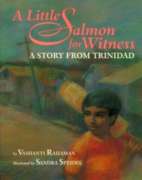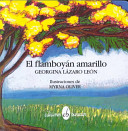
On Good Friday, a school holiday in Trinidad, Rajiv spends the day searching for a special birthday present for his grandmother.

On Good Friday, a school holiday in Trinidad, Rajiv spends the day searching for a special birthday present for his grandmother.

In poems that ring with Caribbean rhythm, Lynn Joseph follows a young girl in Trinidad throughout her day, from arriving late at school to pulling fishing nets from the sea. Illustrated with glowing pastels that burst with the color and spirit of island life. Full-color illustrations.

Francisco is finally old enough to journey to the mango grove all by himself to gather the mangoes for a special dinner. But bees swarm the fruit, and Francisco has trouble picking them from the tree. He returns to his father several times, and each time his father shares a different proverb to inspire Francisco to continue trying. “Querer es poder. Where there’s a will, there’s a way!” Finally, Francisco is able to gather some mangoes, and on his way home he stops to visit his uncle, grandmother, and aunt. Francisco shares his mangoes with them, and by the time he gets home he no longer has any! “Es mejor dar que recibir. Sometimes it’s better to give than to receive.” Luckily for Francisco, his generosity does not go unnoticed. “Amor con amor se paga. Love is repaid with love.” Readers are sure to be charmed by this humorous story about problem solving and sharing. The book includes a glossary of Spanish words.

Mamá, Papá, Sister, and Brother Ratón go for a picnic on a beautiful day. After a delicious lunch of medianoches and lemonade, Mamá and Papá smooch—eeewww!—and Brother and Sister must find something to do. And what could be more fun than teasing the cat behind the fence? But the fence isn’t as high as they think! Faster than they can say, “Adios, Gato!” Brother and Sister are racing back to Mamá and Papá with the cat in pursuit. The brave Ratón family knows what to do—hide behind Mamá! But what will Mamá do?

With her signature narrative grace, Edwidge Danticat brings Haiti’s beautiful queen Anacaona to life. Queen Anacaona was the wife of one of her island’s rulers, and a composer of songs and poems, making her popular among her people. Haiti was relatively quiet until the Spanish conquistadors discovered the island and began to settle there in 1492. The Spaniards treated the natives very cruelly, and when the natives revolted, the Spanish governor of Haiti ordered the arrests of several native nobles, including Anacaona, who was eventually captured and executed, to the horror of her people.

When asked to deliver contraband papers to her native island home of Cuba in 1852, twenty-year-old Emilia Casanova gulped audibly in a most unladylike manner. This was her chance to be in the thick of the rebellion against Spanish authority something she had always dreamed of instead of on the sidelines more befitting someone of her station. Even though she would be branded a traitor and endanger her family if she was caught, she pushed her fear aside and accepted the mission.
Back in Cuba following her first summer abroad, distributing seditious propaganda isn’t as easy as it had seemed while in New York. But she honors her commitment to the Junta Cubana, a group of Cuban revolutionaries living in exile in the U.S., and begins her efforts to convert compatriots to the cause of independence from Spain. She begins planting the seeds of insubordination in her social circle and enlists two of her brothers in the cause. Things become more dangerous when she targets soldiers in the garrison close to the family’s home, and it doesn’t take long for one of her brothers to be exposed. Soon Emilia’s father is forced to lead his entire family away from their home and into exile in the U.S.
Raised in an elite, slave-holding Cuban family, Emilia Casanova spent most of her adult life in New York City, where she worked passionately for Cuba’s freedom from Spain and the black man’s freedom from servitude. A wife and mother, she created the first women’s political organization dedicated to supporting the rebel cause during Cuba’s Ten Years’ War. Puerto Rican and Latino Studies professor Virginia Sanchez-Korrol introduces the fascinating but little-known story of a Latin American activist to an English-speaking audience.

Provides comprehensive information on the geography, history, wildlife, governmental structure, economy, cultural diversity, peoples, religion, and landmarks of Puerto Rico.

Presents the geography, history, economy, and culture of the people of Haiti.

A boy planted what he belives to be a yellow poinciana seed but to his surprise the seed produced a red poincina tree.
 This story is about two individuals that cared for each other. It starts with “El Conde Olinos” singing to his horse while he gives him water, on the shores of the sea. The queen hears him and encourages her daughter to listen to the song. The girl innocently reveals the name of the singer, uncovering some loves that are not to the taste of the mother who announces, “ I will send him to kill”. Their threats are fulfilled, and the two lovers die. But the lovers become two birds that will fly together.
This story is about two individuals that cared for each other. It starts with “El Conde Olinos” singing to his horse while he gives him water, on the shores of the sea. The queen hears him and encourages her daughter to listen to the song. The girl innocently reveals the name of the singer, uncovering some loves that are not to the taste of the mother who announces, “ I will send him to kill”. Their threats are fulfilled, and the two lovers die. But the lovers become two birds that will fly together.